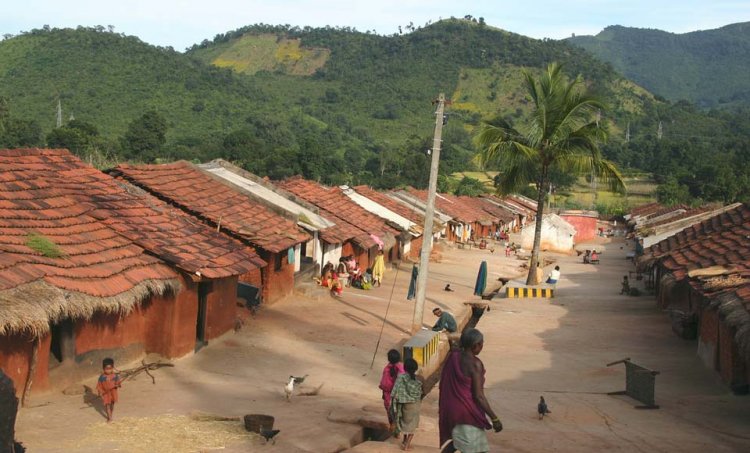Context:
Recently, the Union Cabinet approved Pradhan Mantri Janjatiya Unnat Gram Abhiyan to improve the socio-economic condition of tribal communities.
Key Highlights of the Mission
- The Union Cabinet approved PM-JUGA with a total outlay of Rs.79,156 crore over five years.
- Aim: To improve the socio-economic condition of tribal communities, by adopting saturation coverage for tribal families in tribal-majority villages and aspirational districts.
- It will address critical gaps in social infrastructure, health, education, and livelihoods through the convergence of various government schemes, ensuring holistic and sustainable development of tribal areas and communities.
- Coverage: The Mission will cover 63,000 villages, benefiting over 5 crore tribal people across 549 districts and 2,740 blocks in 30 states and UTs, as announced in the 2024-25 Budget.
- As per Census 2011, India has ST population of 10.45 crore with more than 700 ST communities, out of which 75 communities located in 18 States and the Union Territory of Andaman and Nicobar Islands have been categorized as Particularly Vulnerable Tribal Groups (PVTGs).
- Implementation: The Mission comprises of 25 interventions to be implemented by 17-line ministries through funds allocated under the Development Action Plan for Scheduled Tribes (DAPST) in the next 5 years.
- The Mission is based on the learnings and success of PM-JANMAN (Pradhan Mantri Janjati Adivasi Nyaya Maha Abhiyan).
- The tribal villages covered under the Abhiyan will be mapped on the PM Gati Shakti Portal and the best-performing districts will be awarded.
PM JANMAN Scheme
- The Ministry of Tribal Affairs launched the PM-JANMAN scheme on Janjatiya Gaurav Divas on 15th November, 2023 to cover 75 Particularly Vulnerable Tribal Groups (PVTGs) communities.
- It aims to uplift the socio-economic status of PVTGs by addressing gaps in health, education, livelihoods, and infrastructure.
- With an outlay of ₹24,104 crore, it focuses on 11 key interventions through 9-line Ministries.
Particularly Vulnerable Tribal Groups (PVTG) communities
- In 1975, the Government of India created a separate category called PVTGs (on the recommendation of the Dhebar Commission) out of Schedule Tribes and declared 52 such groups, while in 1993 an additional 23 groups were added to the category, making it a total of 75 PVTGs.
- According to the 2011 Census, the 75 PVTGs reside in 18 States and UT of A&N Islands.
- Among the 75 listed PVTGs, Orissa has the highest (13) number of them.
- The PVTG of Sahariyas has the highest population whereas the PVTGs of Sentineles and Andamanese have a very small population.
Mission Goals:
Goal-I: Developing Enabling Infrastructure:
- Eligible ST households shall have access to pucca housing under the Pradhan Mantri Awas Yojana PMAY (Gramin) with access to tapped water (Jal Jeevan Mission) and electricity supply (Revamped Distribution Sector Scheme – RDSS), and Ayushman Bharat Card (PMJAY).
- Ensuring all-weather road connectivity to ST majority villages (PMGSY), provide access to mobile connectivity (Bharat Net) and internet, and infrastructure for improving health, nutrition, and education (NHM, Samagra Shiksha and Poshan).
Goal-2: Promotion of Economic Empowerment:
- Promote skill development and entrepreneurship through training (Skill India Mission/JSS) and access to long-term skill courses for ST youth.
- Provide marketing support via Tribal Multipurpose Marketing Centres (TMMC), tourist homestays, and support for agriculture, animal husbandry, and fisheries for FRA Patta holders.
Goal-3: Universalization of Access to Good Education:
- To increase the Gross enrolment ratio (GER) to the national levels in school and higher education and accessible to ST students (Samagra Shiksha Abhiyan) by setting up tribal hostels in schools at the district/block level.
Goal-4: Healthy Lives and Dignified Ageing:
- Ensure access to quality healthcare for ST households, aiming to meet national standards in IMR, MMR, and immunisation coverage through Mobile Medical Units in underserved areas (National Health Mission).
Innovative schemes under PM-JUGA
- Tribal Home Stay: Around 1000 Home stays will be promoted under Swadesh Darshan through the Ministry of Tourism. For this, each household would be given ₹5 lakh to build a fresh two-room homestay or ₹3 lakh to renovate existing structures into homestays. The scheme also provides for ₹5 lakh for “village community requirement”.
- Sustainable Livelihood Forest Right Holders (FRA): Special focus on 22 lakh FRA patta holders (under Forest Rights Act (FRA)) residing in forest areas to secure forest rights and empower tribal communities.
- Improving infrastructure of Govt residential Schools and Hostels: To develop local educational resources and promote enrolment and retention, the Abhiyan aims to improve the infrastructure of Ashram schools/hostels/Tribal schools /Govt residential schools for upgradation on the lines of PM-Shri Schools.
- Advanced facilities for diagnosis of Sickle Cell Disease (SCD): To provide affordable and accessible diagnostic and SCD management facilities with special emphasis on pre-natal diagnosis and to reduce the prevalence of the disease by preventing future births with SCD.
- Tribal Multipurpose Marketing Centre (TMMC): Around 100 TMMCs will be set up to enable the tribal producers to get the right price for their produce/ products and facilitate the consumers in buying tribal produce/products at the right price directly from the tribals.

